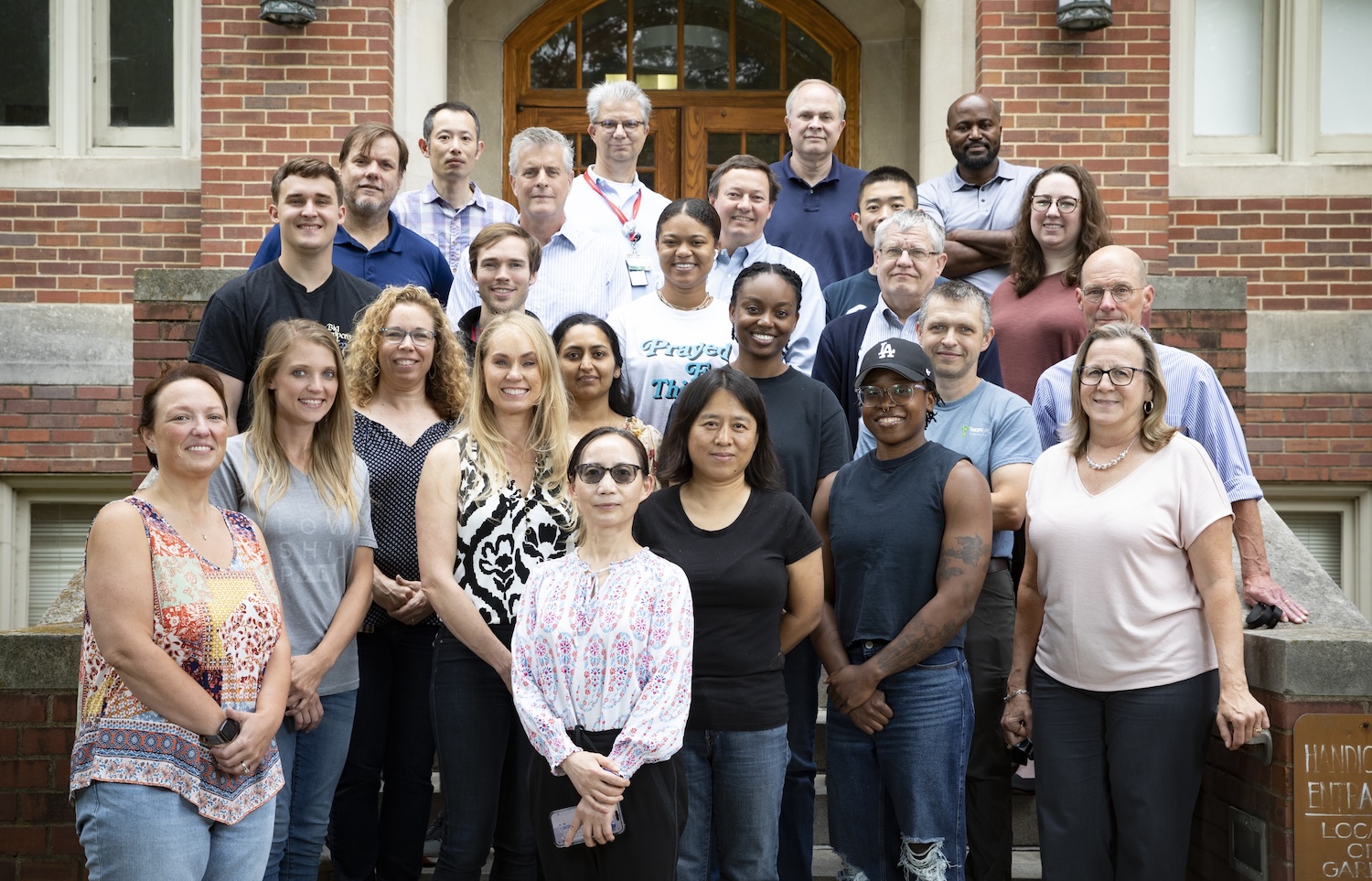The Vanderbilt Anesthesiology Basic Science Research program was established to build bridges between clinical and basic sciences. Anesthesiologists and intensivists are confronted with a vast array of patient diseases. Modern anesthesiology and critical care medicine depend on translational knowledge derived from the basic research laboratory to advance patient care. The department's philosophy is to define fundamental aspects of immunology, metabolism, biochemistry, pharmacology and physiology at the molecular and cellular levels, and where appropriate, to ensure that this knowledge is translated into improved clinical practice.
Basic scientists in the department have extensive expertise in electrophysiology, digital microscopy, molecular biology, neurophysiology, immunology, genetics and cellular-, organ system- and integrative physiology. Our scientists are well-funded by the National Institutes of Health, Veterans Administration, American Heart Association and other extramural sources.
Basic research activities in the department focus broadly on cell membrane physiology, neuroscience, cardiovascular physiology, immunology, inflammation and oxidative stress. Current research efforts include drug discovery for ion channels; structure/function analysis of voltage-gated Cl-, Na+ and K+ channels; molecular physiology of cation-coupled chloride cotransporters and their role in GABAergic neurotransmission; physiological and molecular characterization of neurosecretion and its regulation by G proteins and Ca2+; neurobiology of pain and addiction; inflammation and antimicrobial immunity in critically ill patients and organ injury after cardiopulmonary arrest.
Eric Delpire, PhD, Professor of Anesthesiology & Molecular Physiology & Biophysics, was named the Division Chief of Basic Science Research in 2010 and serves as leader of the Basic Science Division. Dr. Delpire has been a member of the Vanderbilt University Medical School faculty since 1997.
-

Dr. Julia Bohannon joined the Department of Anesthesiology at Vanderbilt University Medical Center as a postdoctoral fellow in 2012, became junior faculty in 2015, and is now a tenured Associate Professor of Anesthesiology and Pathology, Microbiology, and Immunology. Her laboratory develops immunomodulatory therapies to reduce life-threatening infections and sepsis in patients with severe burn injury.
Infections remain the leading cause of death and prolonged hospitalization after major burns, due to loss of skin barrier, immune suppression, and rising antibiotic resistance. The Bohannon Lab addresses this challenge by targeting the host immune system to restore antimicrobial defenses.
The team studies how burn injury alters mitochondrial function, metabolism, and innate immune cell capacity, and how Toll-like receptor (TLR) agonists can reverse these deficits. Foundational work with the TLR4 agonist monophosphoryl lipid A (MPLA) revealed MyD88-dependent trained immunity and showed that MPLA reprograms neutrophils and monocytes to enhance bacterial clearance. These discoveries led to the lab’s patented synthetic TLR4 agonist, PHAD, now advancing through clinical trials in collaboration with Revelation Biosciences.
Complementing this preclinical work, the lab’s clinical arm analyzes innate immune cells collected from burn patients over time and tests whether ex vivo exposure to TLR agonists can restore immune function, informing translational strategies to counteract burn-induced immunosuppression.
The Bohannon Lab employs multiple infection models, including Pseudomonas aeruginosa, Klebsiella pneumoniae, Staphylococcus aureus, and Candida albicans, to rigorously evaluate therapeutic approaches. Bridging basic discovery with clinical translation, the lab aims to deliver host-directed therapies that reduce infection risk and improve outcomes for critically ill, burn patients.
-

The work in Dr. Bruehl’s lab is focused on understanding acute and chronic pain and enhancing pain management. For more than 10 years, a key focus of the lab has been on understanding the physiological (endogenous pain inhibitory function) and psychosocial factors that influence the benefits versus risks experienced when individuals use opioid analgesics for pain management. The lab’s current work examines several hypothesized mechanisms that may contribute to known associations between elevated stress and risk for opioid misuse. Mechanisms being examined in this work include operant reinforcement (by subjective opioid effects), endogenous opioid function, endocannabinoids and vagal inhibition (indexed by heart rate variability). Dr. Bruehl’s lab has also previously conducted studies seeking to understand the mechanisms underlying beneficial effects of non-pharmacological interventions for chronic pain (aerobic exercise training, mindfulness, spinal manipulation therapy).
Another current focus of the Bruehl lab is on evaluating the role of oxidative stress as a contributor to adverse postsurgical pain outcomes. The lab is conducting an NIH-funded randomized clinical trial of a potent antioxidant intervention as a means of reducing the risk for adverse long-term pain outcomes following total knee arthroplasty surgery (TKA).
Several junior investigators (supported in part by NIH K-23 training grants) also conduct mentored pain research in Dr. Bruehl’s lab. Ongoing and planned studies address topics including:
- how parent and child psychosocial factors interact to influence parental decisions regarding use of opioid analgesics in their children following surgery,
- comparing analgesic and misuse-relevant subjective effects of oxycodone vs. buprenorphine with the goal of determining whether buprenorphine might have clinical utility in the post-surgical pain management setting but with lower misuse risk than typical opioids,
- understanding the extent to which mechanisms of chronic pain and autism may overlap and account for the apparent increased risk of chronic pain in autistic youth,
- genetic factors that may contribute to central sensitization to pain and opioid use patterns, and
- application of artificial intelligence to permit individualized pain management (precision pain medicine).
Dr. Bruehl’s work is conducted in both the laboratory and clinical settings and employs multiple methodologies. These include static (pain threshold, pain tolerance) and dynamic (temporal summation of pain, conditioned pain modulation) quantitative sensory testing, psychometric assessment, biological sampling (endocannabinoids, beta-endorphin, F2-isoprostanes, proinflammatory cytokines) and placebo-controlled administration of both opioid analgesics and opioid antagonists (the latter to evaluate endogenous opioid function).
Overall, the goal of the research in Dr. Bruehl’s lab is to better understand the biopsychosocial factors contributing to chronic pain and its related health risks, and ultimately, to improve treatment of chronic pain while mitigating against the risks associated with opioid analgesic use.
-
GABAergic neurotransmission depends upon the transmembrane Cl concentration gradient that exists at the synapse. The intracellular Cl concentration in CNS and PNS neurons is regulated, in part, by cation-chloride cotransport mechanisms such as Na-K-2Cl and K-Cl cotransporters. For example, the inward Na-K-2Cl cotransporter is highly expressed in immature CNS neurons, resulting in a high intracellular Cl- concentration and GABA depolarizing or excitatory responses. In contrast, mature CNS neurons have low Na-K-2Cl cotransporter and high K-Cl cotransporter leading to low intracellular Cl- and GABA hyperpolarizing or inhibitory responses.
The Delpire Laboratory is creating and studying genetically-modified mouse models of the cotransporters and of proteins that regulate them. The work, involves molecular biology, physiology, electrophysiology and behavior. These studies have significance in pain perception, hyper-excitability and epilepsy, nerve conduction, peripheral neuropathy and paraplegia. In the 2009-2010 academic year, the laboratory graduated one student in the neuroscience program, published nine research articles, two scientific reviews, nine meeting abstracts, a book, and four book chapters. The laboratory, with the support of the departments of Anesthesiology and Molecular Physiology & Biophysics, also hosted the first annual meeting of the Tennessee Physiological Society.
-

Dr. Jerod Denton leads a discovery-driven research program focused on ion channel pharmacology and chemical biology, with direct translational applications in renal, neurological, vascular, reproductive and metabolic health. His lab integrates high-throughput library screening, electrophysiology, and structure-guided medicinal chemistry to develop first-in-class small-molecule modulators of clinically relevant ion channels. These include Kir1.1, Kir4.1/5.1, Kir6.2/SUR1, Kir6.1/SUR2B, Kir7.1, Kv3.1, and TMEM175, among others. His group’s ion channel modulators serve as both tool compounds for mechanistic dissection and development candidates for drug discovery pipelines.
Visit the website for the lab of Dr. Jerod Denton, researching Potassium Channel Pharmacology and Physiology.
-

In October 2012, Brad Grueter, PhD, and Carrie Grueter, PhD, joined the Department. This husband and wife are both doctoral graduates of the Department of Molecular Physiology and Biophysics at Vanderbilt University. The goal of the Grueter lab research program is to advance the current understanding of the nucleus accumbens (NAc), a brain region responsible for integrating information from diverse inputs and modifying complex motivated behaviors, including its involvement in adaptive responses to rewarding and aversive stimuli. Specifically, we strive to elucidate the molecular constituents in the NAc that are necessary and sufficient to drive complex motivated behaviors. As part of the mesolimbic dopamine system, the NAc integrates a complex mix of excitatory, inhibitory and modulatory inputs to optimize adaptive motivated behaviors. Dynamic alterations in synaptic transmission within this circuitry are strongly implicated in the development and expression of many neuropsychiatric disorders. Thus, two broad questions we address are: 1) how does in vivo experience such as cocaine exposure, pain, or high fat diet alter the neurocircuitry of the NAc? 2.) What are the synaptic mechanisms underlying the behavioral adaptations to in vivo experience? The approaches we incorporate allow us to thoroughly characterize the synaptic circuitry of the NAc in basal and pathophysiological conditions using a combination of cutting edge techniques in electrophysiology, molecular biology, metabolic phenotyping, optogenetics and behavior. These studies will provide information on how the NAc circuits integrate environmental stimuli and allow for specific behavioral responses. This enhanced understanding of NAc function may provide a basis for a more individualized approach to the treatment of many psychiatric disorders.
-

1) Innovative strategies to improve neurological outcome and survival after cardiac arrest
Together with colleagues at the University of Minnesota, the University of Michigan and the Medical College of Wisconsin, Dr. Riess’ team investigates novel strategies such as ischemic and pharmacologic postconditioning to improve neurological outcome and survival after cardiac arrest and cardiopulmonary resuscitation (CPR). Currently, with only a five to seven percent survival rate after out-of-hospital cardiac arrest, the ground-breaking findings of this inter-institutional and -disciplinary collaboration are highly promising for thousands of patients each year.
2) Effect of frequent comorbidities and chronic medications on outcome after cardiac arrest and resuscitation
Risk factors for heart disease and cardiac arrest include diabetes, hyperlipidemia and obesity, yet it remains unknown how these and their respective treatments may affect outcome after cardiac arrest and resuscitation, or otherwise highly promising strategies, to improve neurologically favorable survival. Dr. Riess’ laboratory has established an in vivo rat model of cardiac arrest and CPR, combined with continuous electroencephalography, to assess the interaction of comorbidities and treatment strategies on neurologically favorable survival.
3) Novel copolymer-based cell membrane stabilizers to attenuate myocardial infarction
The goal of this project is to elucidate signaling pathways and optimize pharmacological protection with synthetic membrane stabilizers to ameliorate myocardial ischemia/reperfusion injury by stabilizing membranes and protecting cellular function. This is an interdisciplinary collaborative effort with researchers in the Department of Biomedical Engineering at Vanderbilt University.
4) Role of Peripheral Intravenous Waveform Analysis (PIVA) in experimental right heart failure
The Riess lab collaborates with researchers from the Department of Anesthesiology and the Department of Biomedical Engineering to assess the role of PIVA in different models of experimental right heart failure such as cardiac arrest, hemorrhagic and septic shock.
5) Biological effects of noble gases
Although chemically inert, noble gases like helium or argon have been shown to exert organ-protective effects against ischemia/reperfusion injury. In collaboration with researchers from the University of Minnesota, the Riess lab investigates their effects on cardiac, pulmonary and vascular function during cardiac arrest and resuscitation.
6) Protective role of fatty acids against myocardial IR injury
In collaboration with investigators at the University of Alaska Fairbanks, Dr. Riess’ team studies the protective role of fatty acids against myocardial IR injury in Arctic Ground Squirrels (AGS). Administration of a clinically used fat emulsion, Intralipid, confers nearly complete abrogation of myocardial dysfunction following IR in AGS isolated hearts, challenging the paradigm of glucose being the fuel of choice during oxidative stress.
Dr. Riess is supported by Zhu Li, PhD, and Matthew Barajas, MD.To contact the lab, call (615) 322-9067; to contact Dr. Riess, call (615) 322-9044 or e-mail to matthias.riess@vanderbilt.edu
-
Dr. Edward Sherwood’s lab is focused on three major studies: Sepsis Pathogenesis, Immunomodulation and Immunotoxicity.
Sepsis PathogenesisOur lab is studying several aspects of sepsis and the systemic inflammatory response syndrome. A major interest is to define mechanisms of sepsis-induced systemic inflammation and organ injury with emphasis on the roles of natural killer (NK) and T lymphocytes. Current studies are being performed to evaluate the mechanisms of NK and T cell activation and chemotaxis during sepsis with emphasis on the chemokine receptor CXCR3 and its ligands, CXCL9 and CXCL10. The Sherwood group showed that CXCR3 activation is crucial for NK cell trafficking during sepsis and that CXCR3 blockade will decrease inflammation and organ injury in experimental models of sepsis. The underlying goal is to further understand the contribution of CXCR3 activation in the pathogenesis of sepsis and develop clinically relevant interventions to block CXCR3 and improve outcome.ImmunomodulationIn further studies, Dr. Sherwood’s lab group is evaluating the immunomodulatory properties of TLR4 agonists and their ability to modify the host response to systemic infection. The group showed that the TLR4 agonists lipopolysaccharide and monophosphoryl lipid A are potent immunomodulators that alter systemic cytokine production and enhance innate resistance to bacterial infections. The improved resistance to infection is caused by neutrophil expansion and enhanced neutrophil functions. The group is working to define the mechanisms by which TLR4 agonists promote the antimicrobial functions of neutrophils and develop TLR4 agonists as agents that can be used clinically to improve the resistance of critically ill patients to infection.ImmunotoxicityAdditionally, our lab is focused on the immunological effects of IL-15 superagonist (IL-15 SA). IL-15 SA is complex composed of IL-15 and its receptor α and currently considered as a new promising candidate for cancer immunotherapy by increasing immunological effects of IL-15. Despite of its potent anti-tumor effect, we found systemic administration of IL-15 SA leads to severe toxicity in mice. Our studies indicate that natural killer cells appear to be the primary cell type mediating IL-15 SA-induced immunotoxicity. The underlying molecular mechanism is associated with production of IFN-γ, a pro-inflammatory cytokine mainly produced by NK cells following IL-15 SA stimulation.
